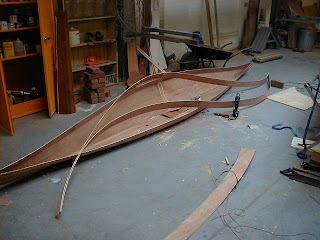
Friday, 1 June 2007
Pastoral Pipes - Bagpipes for all!

Tuesday, 8 May 2007
Build a canoe in a weekend
In the morning we carried on stitching. Jojo came to help, and fed us when we looked hungry.
 So we had to make a million nips, to do the job of clamps.
So we had to make a million nips, to do the job of clamps. 
In the meantime our host, Andy, harkening to the beat of a different drummer, was hacking up yet more joinery pine to make a strip planked boat. The stem was laminated from some well seasoned ash, and a strong back set up on trestles nailed to the floor.

Wednesday, 2 May 2007
The Barge Boat


Friday, 27 April 2007
An Ivory Tenor Recorder

My copy is made from Maple.
This is my copy. It was my first foray into key making, and I had a lot of fun cutting out the brass and filing and polishing it, and making the mechanism work. I had trouble with the key fouling the fontanelle when in the raised position, so the note played flat because it was shaded by the key.
The key makes reaching the lowest note a pleasure - many tenors present quite a stretch in doing so.
The fontanelle is a very thin cylinder of wood perforated by many tiny holes. Its chief function is to protect and hide the key mechanism but by the time I had finished it I felt like making another cover to protect the fontanelle!
I made a stupid mistake when the instrument was nearing completion - The foot is reamed to a bit of a flare, with the same tool that is used to make the bore. I over reamed this flare, ruining it for good. the lowest note now plays c sharp instead of c. Quite useful for playing in d of course, as there is no way of making a c sharp otherwise. Some day I will make another instrument and get it right!
The original ivory has shrunk to an oval section, making it impossible to guess what the original bore was. The bore profile shows a distinct constriction or choke, typical of instruments of this period.
http://www.music.ed.ac.uk/euchmi is the website for the museum that houses the original.
Mr Arnold Myers, the curator of this museum said very kind words about my copy when he saw it, and invited me to Edinburgh to view the original and play the several copies that were made for that purpose.
I think the copying was undertaken by Peter Spohr and presented in the international Symposium of Musical Acoustics, but I havent yet tracked down the paper.
My instrument plays the octave and a half that would be expected of a renaissance tenor, with a very acceptable tone.
Wednesday, 25 April 2007
Moondance, a gaff cutter


 Very Blustery Time.
Very Blustery Time. Several Instruments

This whistle of mine is made from cherry wood, photographed within yards of my home on a cherry tree.
When a woodwind instrument warms up, its pitch sharpens. Not a problem if you are on your own, but difficult when you're playing with other people, as it must be pre-warmed to bring it to its correct pitch. Some makers add a tuning slide, but this is something I havent attempted yet. Unless the inner metal sleeve is very thin indeed, it will introduce perturbations into the bore with dire tuning complications.
A slight dissappointment to me has been that I cant make a whistle as loud as a plastic susato whistle. This is mostly due to the material. Wood is porous, and will remain so no matter how much oil you put in it. The porosity absorbs some of the sound energy. Box wood is amazingly tight grained and very impermeable. You can test the permeability of woods by trying to blow down the end grain, sealing your lips onto the wood.Try it with oak - you can almost breathe through it. Try it with box; nothing. Box wood is the ultimate wood for flutes. However, it is very difficult to obtain in decent sizes. Cherry on the other hand, you can buy in huge lumps from a hardwood dealer, or blag it from tree surgeons.
 This is a rennaisance recorder that I made last year. I like the simplicity of the shape. I like the fact that I found the wood lying about on a dump, and I made a pair that play together beautifully.
This is a rennaisance recorder that I made last year. I like the simplicity of the shape. I like the fact that I found the wood lying about on a dump, and I made a pair that play together beautifully.The block in this recorder is made from Cedar of Lebanon.Strictly speaking its not the best wood - pencil cedar is the more stable for this critical role. However, it smells wonderful when you work it.
Here are some more instruments. The background is not representative of the species that they were made from. On the left is another rennaisance recorder, an early model with poorly undercut toneholes, but nice american cherry that coloured nicely with oiling. The other two are fifes/flutes in maple, which is another suitably dense but easily obtainable wood.



